Analysis of TAN Plc's Financial Statements and Cash Flow Management
VerifiedAdded on 2023/06/10
|11
|2104
|252
Report
AI Summary
This report presents a comprehensive financial analysis of TAN Plc, encompassing the preparation of an income statement and balance sheet for the year ended December 31, 2021, along with detailed ratio calculations, including profitability, liquidity, and efficiency ratios. The analysis offers insights into the company's financial performance and provides advice to current and potential shareholders based on these results. Furthermore, the report includes a six-month cash budget from October 2022 to March 2023, along with strategic recommendations for AMF Ltd's management to effectively manage cash flow during this period. The report leverages financial data to evaluate the company's financial health, offering valuable perspectives on its performance and potential for future growth. The report also provides a summary of the references used to support the analysis and recommendations.
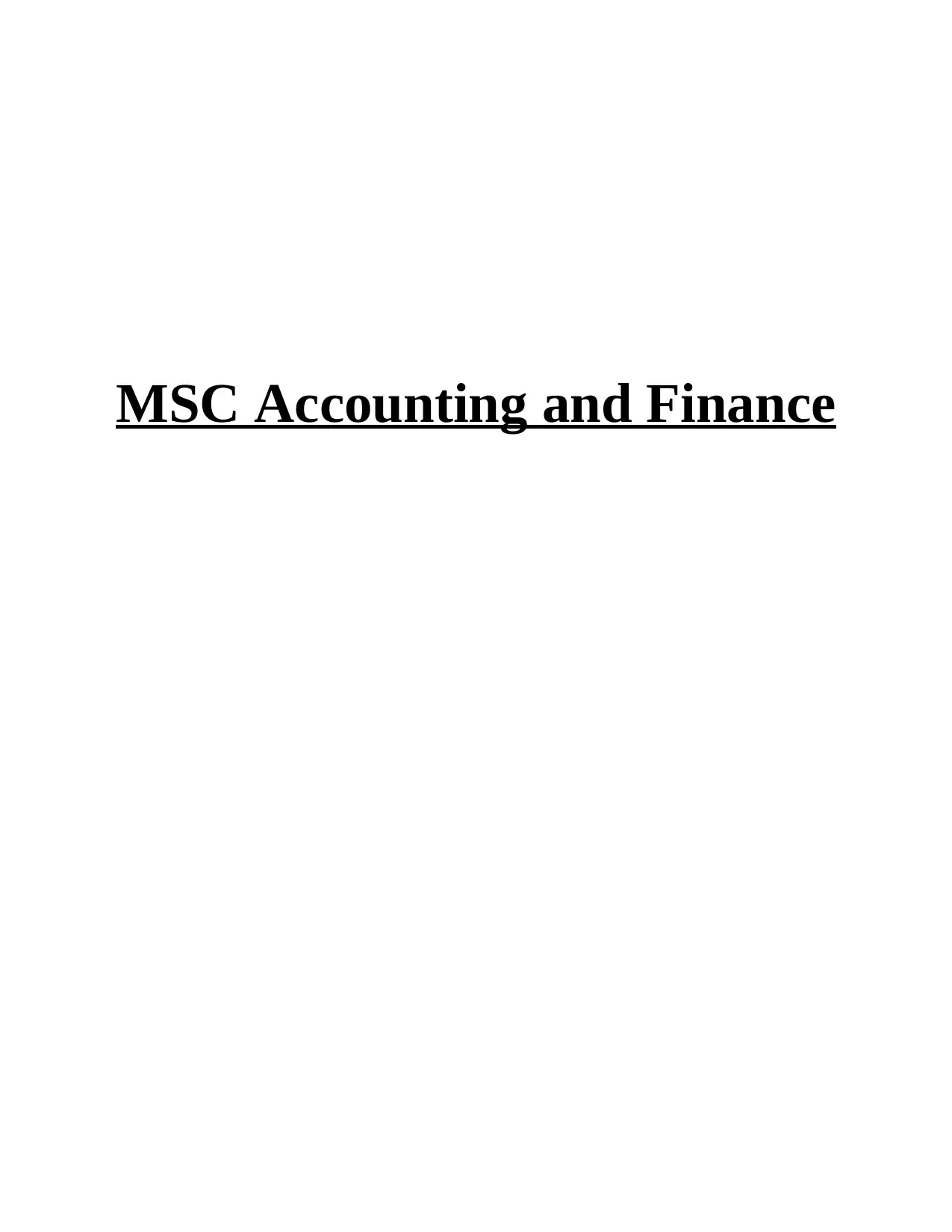
MSC Accounting and Finance
Paraphrase This Document
Need a fresh take? Get an instant paraphrase of this document with our AI Paraphraser
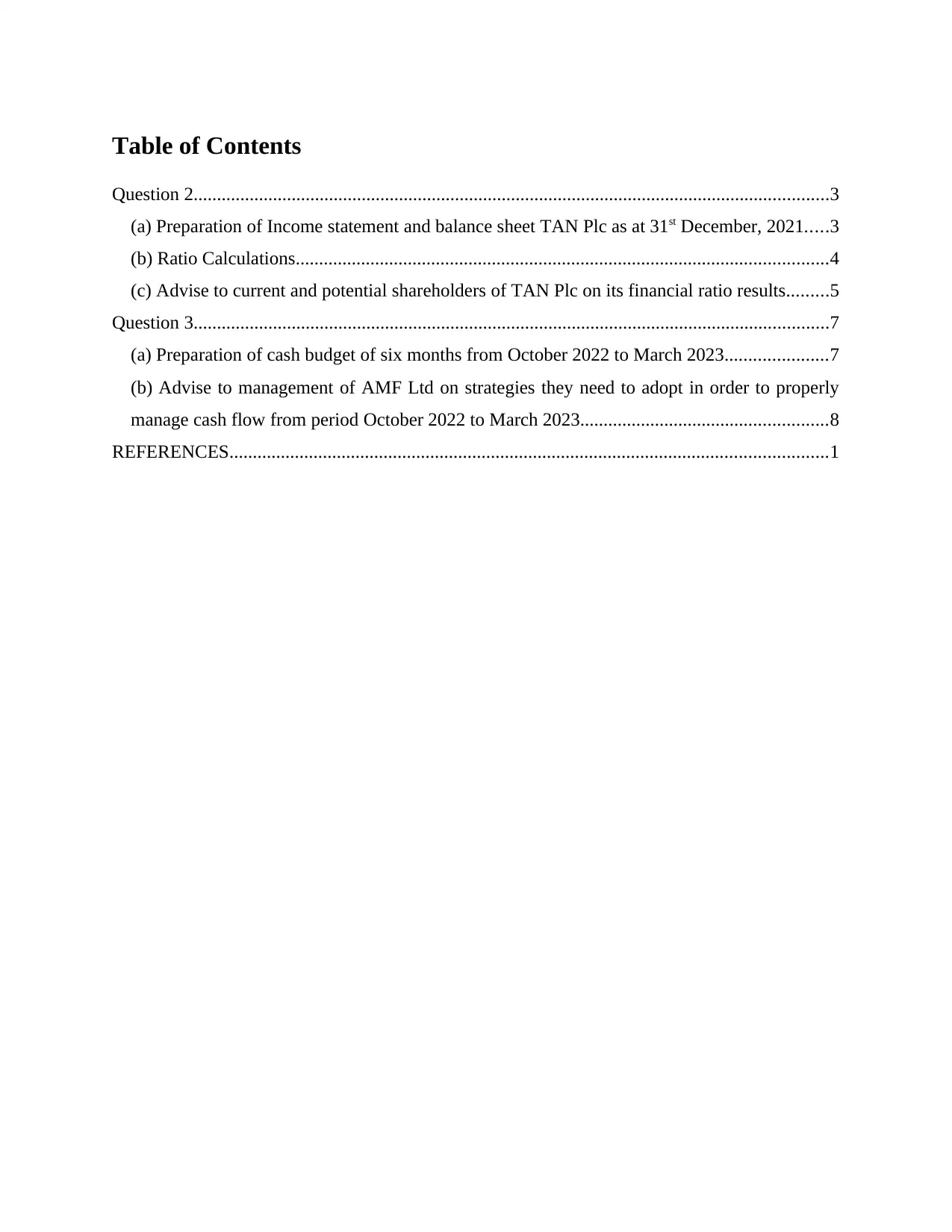
Table of Contents
Question 2........................................................................................................................................3
(a) Preparation of Income statement and balance sheet TAN Plc as at 31st December, 2021.....3
(b) Ratio Calculations..................................................................................................................4
(c) Advise to current and potential shareholders of TAN Plc on its financial ratio results.........5
Question 3........................................................................................................................................7
(a) Preparation of cash budget of six months from October 2022 to March 2023......................7
(b) Advise to management of AMF Ltd on strategies they need to adopt in order to properly
manage cash flow from period October 2022 to March 2023.....................................................8
REFERENCES................................................................................................................................1
Question 2........................................................................................................................................3
(a) Preparation of Income statement and balance sheet TAN Plc as at 31st December, 2021.....3
(b) Ratio Calculations..................................................................................................................4
(c) Advise to current and potential shareholders of TAN Plc on its financial ratio results.........5
Question 3........................................................................................................................................7
(a) Preparation of cash budget of six months from October 2022 to March 2023......................7
(b) Advise to management of AMF Ltd on strategies they need to adopt in order to properly
manage cash flow from period October 2022 to March 2023.....................................................8
REFERENCES................................................................................................................................1
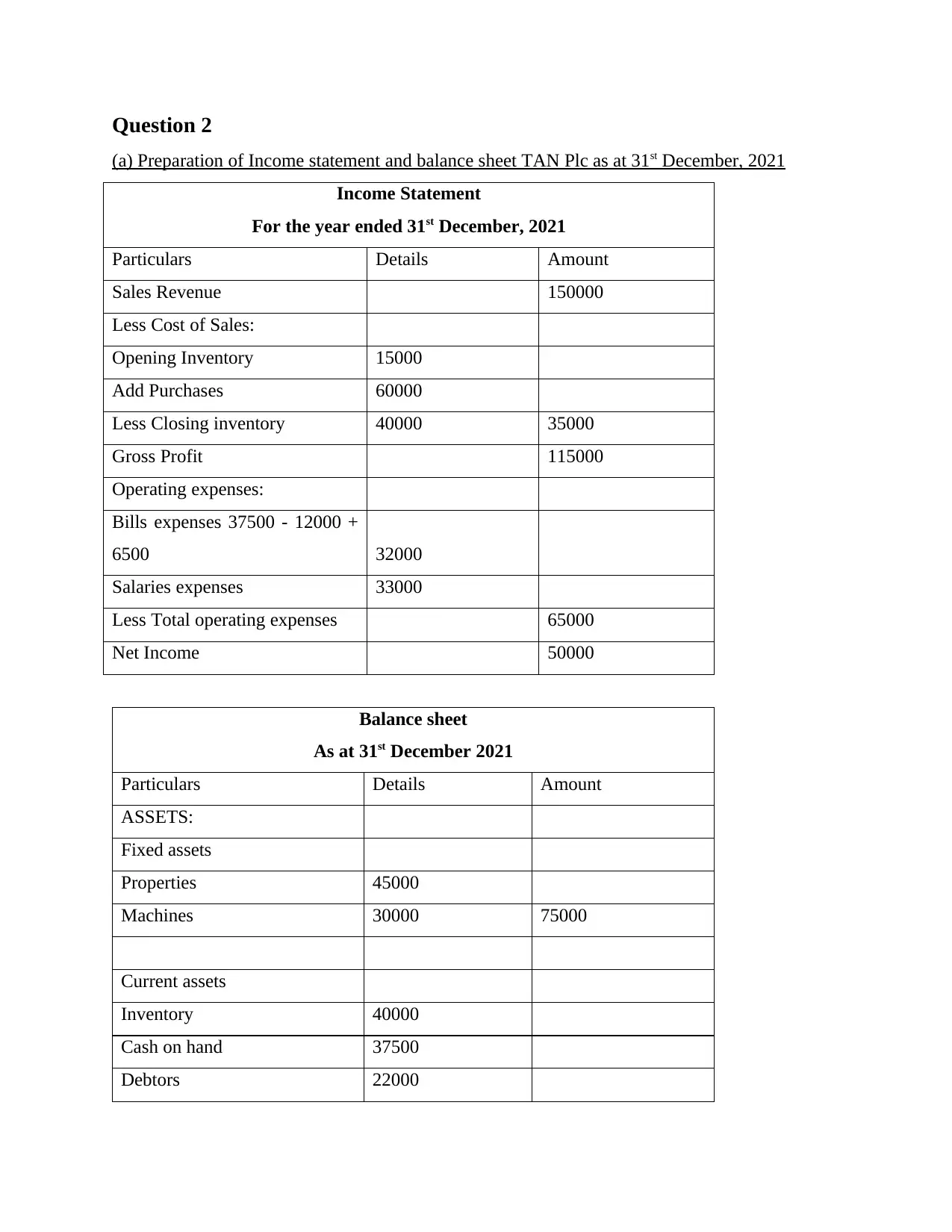
Question 2
(a) Preparation of Income statement and balance sheet TAN Plc as at 31st December, 2021
Income Statement
For the year ended 31st December, 2021
Particulars Details Amount
Sales Revenue 150000
Less Cost of Sales:
Opening Inventory 15000
Add Purchases 60000
Less Closing inventory 40000 35000
Gross Profit 115000
Operating expenses:
Bills expenses 37500 - 12000 +
6500 32000
Salaries expenses 33000
Less Total operating expenses 65000
Net Income 50000
Balance sheet
As at 31st December 2021
Particulars Details Amount
ASSETS:
Fixed assets
Properties 45000
Machines 30000 75000
Current assets
Inventory 40000
Cash on hand 37500
Debtors 22000
(a) Preparation of Income statement and balance sheet TAN Plc as at 31st December, 2021
Income Statement
For the year ended 31st December, 2021
Particulars Details Amount
Sales Revenue 150000
Less Cost of Sales:
Opening Inventory 15000
Add Purchases 60000
Less Closing inventory 40000 35000
Gross Profit 115000
Operating expenses:
Bills expenses 37500 - 12000 +
6500 32000
Salaries expenses 33000
Less Total operating expenses 65000
Net Income 50000
Balance sheet
As at 31st December 2021
Particulars Details Amount
ASSETS:
Fixed assets
Properties 45000
Machines 30000 75000
Current assets
Inventory 40000
Cash on hand 37500
Debtors 22000
⊘ This is a preview!⊘
Do you want full access?
Subscribe today to unlock all pages.

Trusted by 1+ million students worldwide
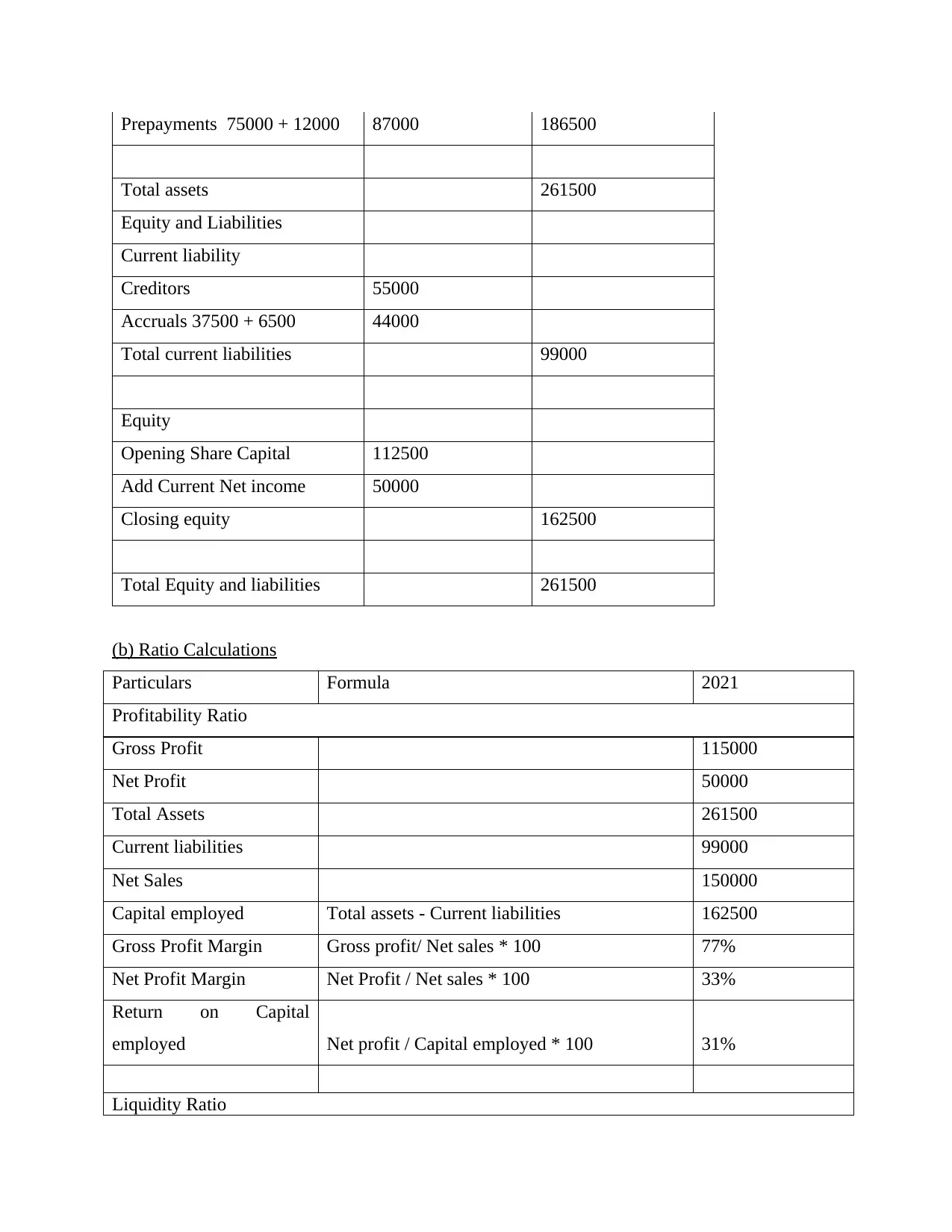
Prepayments 75000 + 12000 87000 186500
Total assets 261500
Equity and Liabilities
Current liability
Creditors 55000
Accruals 37500 + 6500 44000
Total current liabilities 99000
Equity
Opening Share Capital 112500
Add Current Net income 50000
Closing equity 162500
Total Equity and liabilities 261500
(b) Ratio Calculations
Particulars Formula 2021
Profitability Ratio
Gross Profit 115000
Net Profit 50000
Total Assets 261500
Current liabilities 99000
Net Sales 150000
Capital employed Total assets - Current liabilities 162500
Gross Profit Margin Gross profit/ Net sales * 100 77%
Net Profit Margin Net Profit / Net sales * 100 33%
Return on Capital
employed Net profit / Capital employed * 100 31%
Liquidity Ratio
Total assets 261500
Equity and Liabilities
Current liability
Creditors 55000
Accruals 37500 + 6500 44000
Total current liabilities 99000
Equity
Opening Share Capital 112500
Add Current Net income 50000
Closing equity 162500
Total Equity and liabilities 261500
(b) Ratio Calculations
Particulars Formula 2021
Profitability Ratio
Gross Profit 115000
Net Profit 50000
Total Assets 261500
Current liabilities 99000
Net Sales 150000
Capital employed Total assets - Current liabilities 162500
Gross Profit Margin Gross profit/ Net sales * 100 77%
Net Profit Margin Net Profit / Net sales * 100 33%
Return on Capital
employed Net profit / Capital employed * 100 31%
Liquidity Ratio
Paraphrase This Document
Need a fresh take? Get an instant paraphrase of this document with our AI Paraphraser
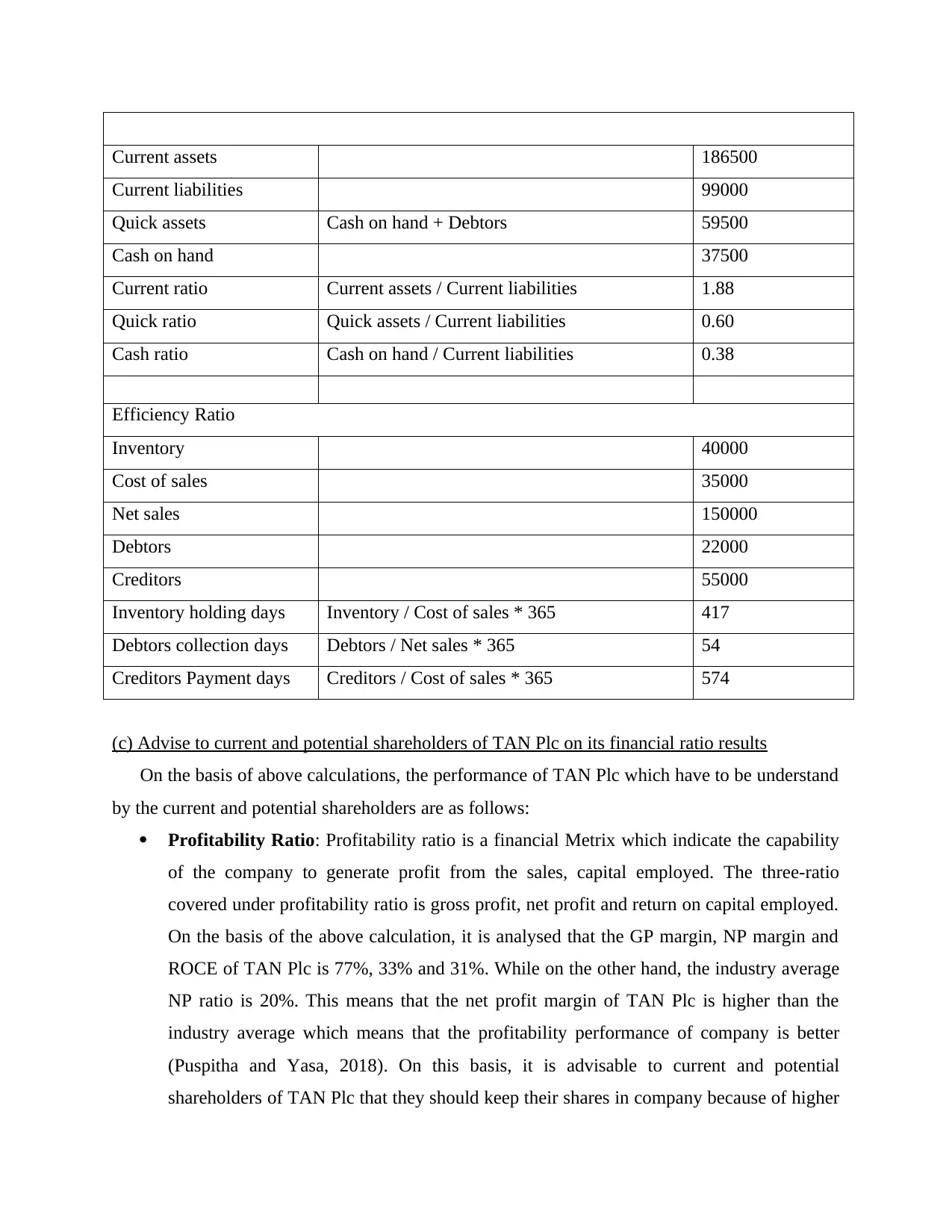
Current assets 186500
Current liabilities 99000
Quick assets Cash on hand + Debtors 59500
Cash on hand 37500
Current ratio Current assets / Current liabilities 1.88
Quick ratio Quick assets / Current liabilities 0.60
Cash ratio Cash on hand / Current liabilities 0.38
Efficiency Ratio
Inventory 40000
Cost of sales 35000
Net sales 150000
Debtors 22000
Creditors 55000
Inventory holding days Inventory / Cost of sales * 365 417
Debtors collection days Debtors / Net sales * 365 54
Creditors Payment days Creditors / Cost of sales * 365 574
(c) Advise to current and potential shareholders of TAN Plc on its financial ratio results
On the basis of above calculations, the performance of TAN Plc which have to be understand
by the current and potential shareholders are as follows:
Profitability Ratio: Profitability ratio is a financial Metrix which indicate the capability
of the company to generate profit from the sales, capital employed. The three-ratio
covered under profitability ratio is gross profit, net profit and return on capital employed.
On the basis of the above calculation, it is analysed that the GP margin, NP margin and
ROCE of TAN Plc is 77%, 33% and 31%. While on the other hand, the industry average
NP ratio is 20%. This means that the net profit margin of TAN Plc is higher than the
industry average which means that the profitability performance of company is better
(Puspitha and Yasa, 2018). On this basis, it is advisable to current and potential
shareholders of TAN Plc that they should keep their shares in company because of higher
Current liabilities 99000
Quick assets Cash on hand + Debtors 59500
Cash on hand 37500
Current ratio Current assets / Current liabilities 1.88
Quick ratio Quick assets / Current liabilities 0.60
Cash ratio Cash on hand / Current liabilities 0.38
Efficiency Ratio
Inventory 40000
Cost of sales 35000
Net sales 150000
Debtors 22000
Creditors 55000
Inventory holding days Inventory / Cost of sales * 365 417
Debtors collection days Debtors / Net sales * 365 54
Creditors Payment days Creditors / Cost of sales * 365 574
(c) Advise to current and potential shareholders of TAN Plc on its financial ratio results
On the basis of above calculations, the performance of TAN Plc which have to be understand
by the current and potential shareholders are as follows:
Profitability Ratio: Profitability ratio is a financial Metrix which indicate the capability
of the company to generate profit from the sales, capital employed. The three-ratio
covered under profitability ratio is gross profit, net profit and return on capital employed.
On the basis of the above calculation, it is analysed that the GP margin, NP margin and
ROCE of TAN Plc is 77%, 33% and 31%. While on the other hand, the industry average
NP ratio is 20%. This means that the net profit margin of TAN Plc is higher than the
industry average which means that the profitability performance of company is better
(Puspitha and Yasa, 2018). On this basis, it is advisable to current and potential
shareholders of TAN Plc that they should keep their shares in company because of higher
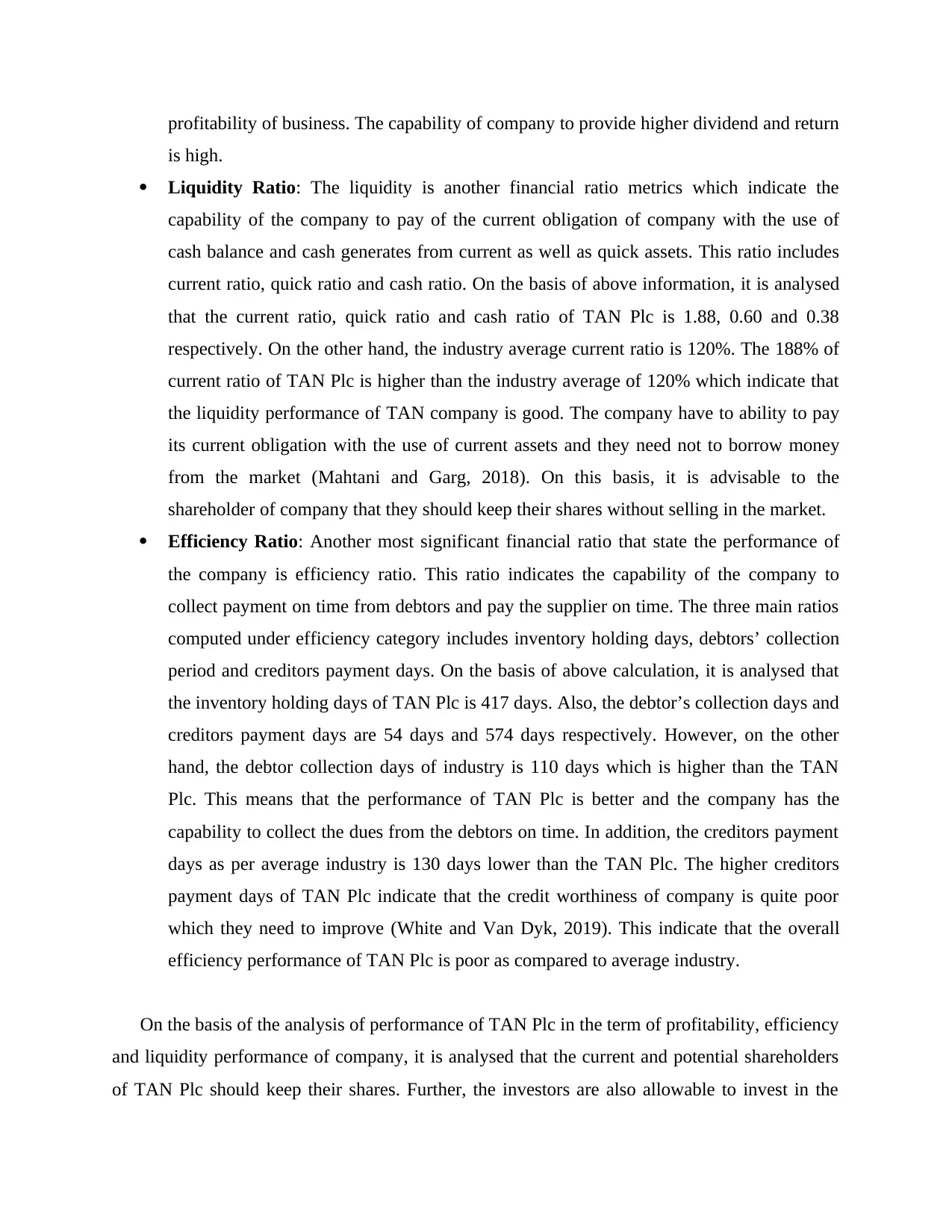
profitability of business. The capability of company to provide higher dividend and return
is high.
Liquidity Ratio: The liquidity is another financial ratio metrics which indicate the
capability of the company to pay of the current obligation of company with the use of
cash balance and cash generates from current as well as quick assets. This ratio includes
current ratio, quick ratio and cash ratio. On the basis of above information, it is analysed
that the current ratio, quick ratio and cash ratio of TAN Plc is 1.88, 0.60 and 0.38
respectively. On the other hand, the industry average current ratio is 120%. The 188% of
current ratio of TAN Plc is higher than the industry average of 120% which indicate that
the liquidity performance of TAN company is good. The company have to ability to pay
its current obligation with the use of current assets and they need not to borrow money
from the market (Mahtani and Garg, 2018). On this basis, it is advisable to the
shareholder of company that they should keep their shares without selling in the market.
Efficiency Ratio: Another most significant financial ratio that state the performance of
the company is efficiency ratio. This ratio indicates the capability of the company to
collect payment on time from debtors and pay the supplier on time. The three main ratios
computed under efficiency category includes inventory holding days, debtors’ collection
period and creditors payment days. On the basis of above calculation, it is analysed that
the inventory holding days of TAN Plc is 417 days. Also, the debtor’s collection days and
creditors payment days are 54 days and 574 days respectively. However, on the other
hand, the debtor collection days of industry is 110 days which is higher than the TAN
Plc. This means that the performance of TAN Plc is better and the company has the
capability to collect the dues from the debtors on time. In addition, the creditors payment
days as per average industry is 130 days lower than the TAN Plc. The higher creditors
payment days of TAN Plc indicate that the credit worthiness of company is quite poor
which they need to improve (White and Van Dyk, 2019). This indicate that the overall
efficiency performance of TAN Plc is poor as compared to average industry.
On the basis of the analysis of performance of TAN Plc in the term of profitability, efficiency
and liquidity performance of company, it is analysed that the current and potential shareholders
of TAN Plc should keep their shares. Further, the investors are also allowable to invest in the
is high.
Liquidity Ratio: The liquidity is another financial ratio metrics which indicate the
capability of the company to pay of the current obligation of company with the use of
cash balance and cash generates from current as well as quick assets. This ratio includes
current ratio, quick ratio and cash ratio. On the basis of above information, it is analysed
that the current ratio, quick ratio and cash ratio of TAN Plc is 1.88, 0.60 and 0.38
respectively. On the other hand, the industry average current ratio is 120%. The 188% of
current ratio of TAN Plc is higher than the industry average of 120% which indicate that
the liquidity performance of TAN company is good. The company have to ability to pay
its current obligation with the use of current assets and they need not to borrow money
from the market (Mahtani and Garg, 2018). On this basis, it is advisable to the
shareholder of company that they should keep their shares without selling in the market.
Efficiency Ratio: Another most significant financial ratio that state the performance of
the company is efficiency ratio. This ratio indicates the capability of the company to
collect payment on time from debtors and pay the supplier on time. The three main ratios
computed under efficiency category includes inventory holding days, debtors’ collection
period and creditors payment days. On the basis of above calculation, it is analysed that
the inventory holding days of TAN Plc is 417 days. Also, the debtor’s collection days and
creditors payment days are 54 days and 574 days respectively. However, on the other
hand, the debtor collection days of industry is 110 days which is higher than the TAN
Plc. This means that the performance of TAN Plc is better and the company has the
capability to collect the dues from the debtors on time. In addition, the creditors payment
days as per average industry is 130 days lower than the TAN Plc. The higher creditors
payment days of TAN Plc indicate that the credit worthiness of company is quite poor
which they need to improve (White and Van Dyk, 2019). This indicate that the overall
efficiency performance of TAN Plc is poor as compared to average industry.
On the basis of the analysis of performance of TAN Plc in the term of profitability, efficiency
and liquidity performance of company, it is analysed that the current and potential shareholders
of TAN Plc should keep their shares. Further, the investors are also allowable to invest in the
⊘ This is a preview!⊘
Do you want full access?
Subscribe today to unlock all pages.

Trusted by 1+ million students worldwide
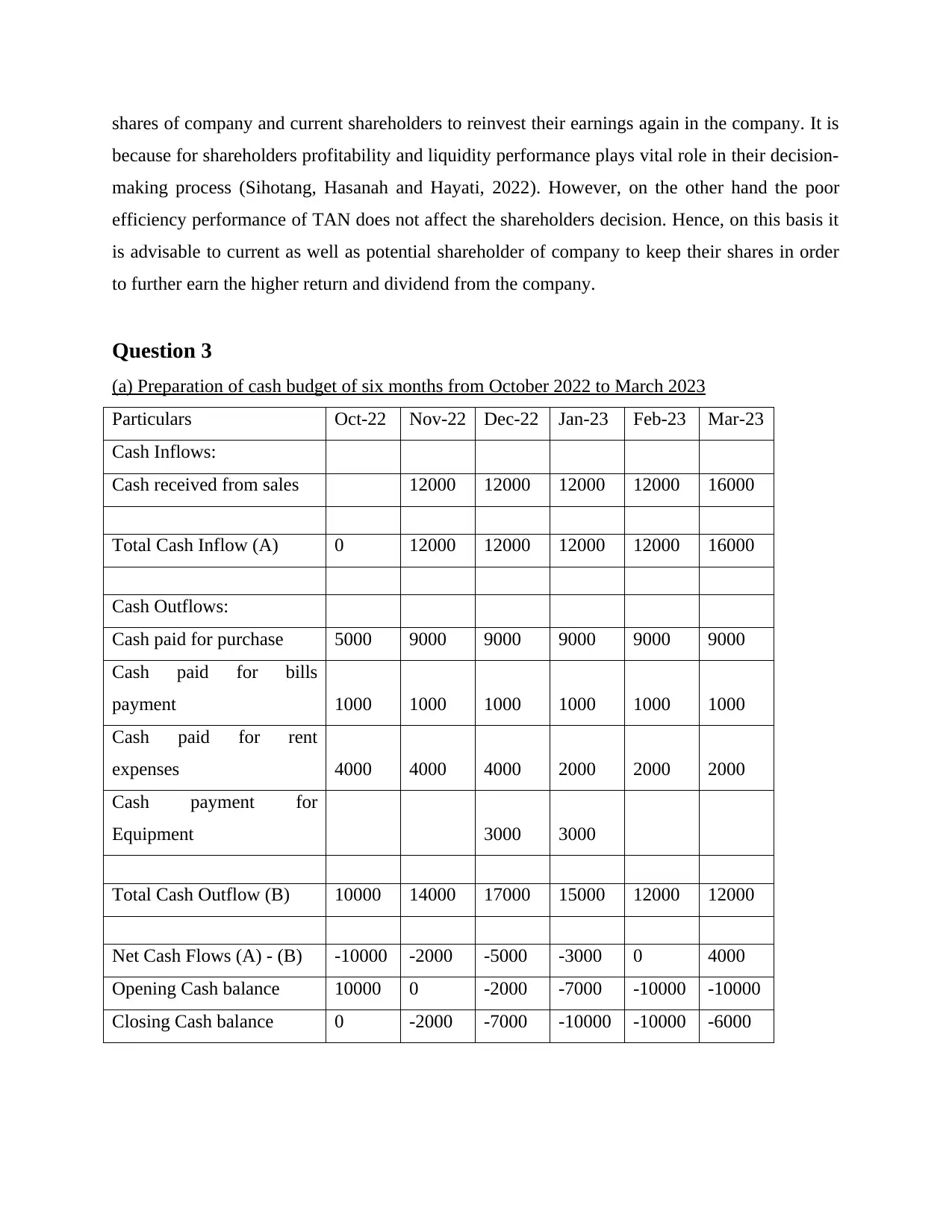
shares of company and current shareholders to reinvest their earnings again in the company. It is
because for shareholders profitability and liquidity performance plays vital role in their decision-
making process (Sihotang, Hasanah and Hayati, 2022). However, on the other hand the poor
efficiency performance of TAN does not affect the shareholders decision. Hence, on this basis it
is advisable to current as well as potential shareholder of company to keep their shares in order
to further earn the higher return and dividend from the company.
Question 3
(a) Preparation of cash budget of six months from October 2022 to March 2023
Particulars Oct-22 Nov-22 Dec-22 Jan-23 Feb-23 Mar-23
Cash Inflows:
Cash received from sales 12000 12000 12000 12000 16000
Total Cash Inflow (A) 0 12000 12000 12000 12000 16000
Cash Outflows:
Cash paid for purchase 5000 9000 9000 9000 9000 9000
Cash paid for bills
payment 1000 1000 1000 1000 1000 1000
Cash paid for rent
expenses 4000 4000 4000 2000 2000 2000
Cash payment for
Equipment 3000 3000
Total Cash Outflow (B) 10000 14000 17000 15000 12000 12000
Net Cash Flows (A) - (B) -10000 -2000 -5000 -3000 0 4000
Opening Cash balance 10000 0 -2000 -7000 -10000 -10000
Closing Cash balance 0 -2000 -7000 -10000 -10000 -6000
because for shareholders profitability and liquidity performance plays vital role in their decision-
making process (Sihotang, Hasanah and Hayati, 2022). However, on the other hand the poor
efficiency performance of TAN does not affect the shareholders decision. Hence, on this basis it
is advisable to current as well as potential shareholder of company to keep their shares in order
to further earn the higher return and dividend from the company.
Question 3
(a) Preparation of cash budget of six months from October 2022 to March 2023
Particulars Oct-22 Nov-22 Dec-22 Jan-23 Feb-23 Mar-23
Cash Inflows:
Cash received from sales 12000 12000 12000 12000 16000
Total Cash Inflow (A) 0 12000 12000 12000 12000 16000
Cash Outflows:
Cash paid for purchase 5000 9000 9000 9000 9000 9000
Cash paid for bills
payment 1000 1000 1000 1000 1000 1000
Cash paid for rent
expenses 4000 4000 4000 2000 2000 2000
Cash payment for
Equipment 3000 3000
Total Cash Outflow (B) 10000 14000 17000 15000 12000 12000
Net Cash Flows (A) - (B) -10000 -2000 -5000 -3000 0 4000
Opening Cash balance 10000 0 -2000 -7000 -10000 -10000
Closing Cash balance 0 -2000 -7000 -10000 -10000 -6000
Paraphrase This Document
Need a fresh take? Get an instant paraphrase of this document with our AI Paraphraser
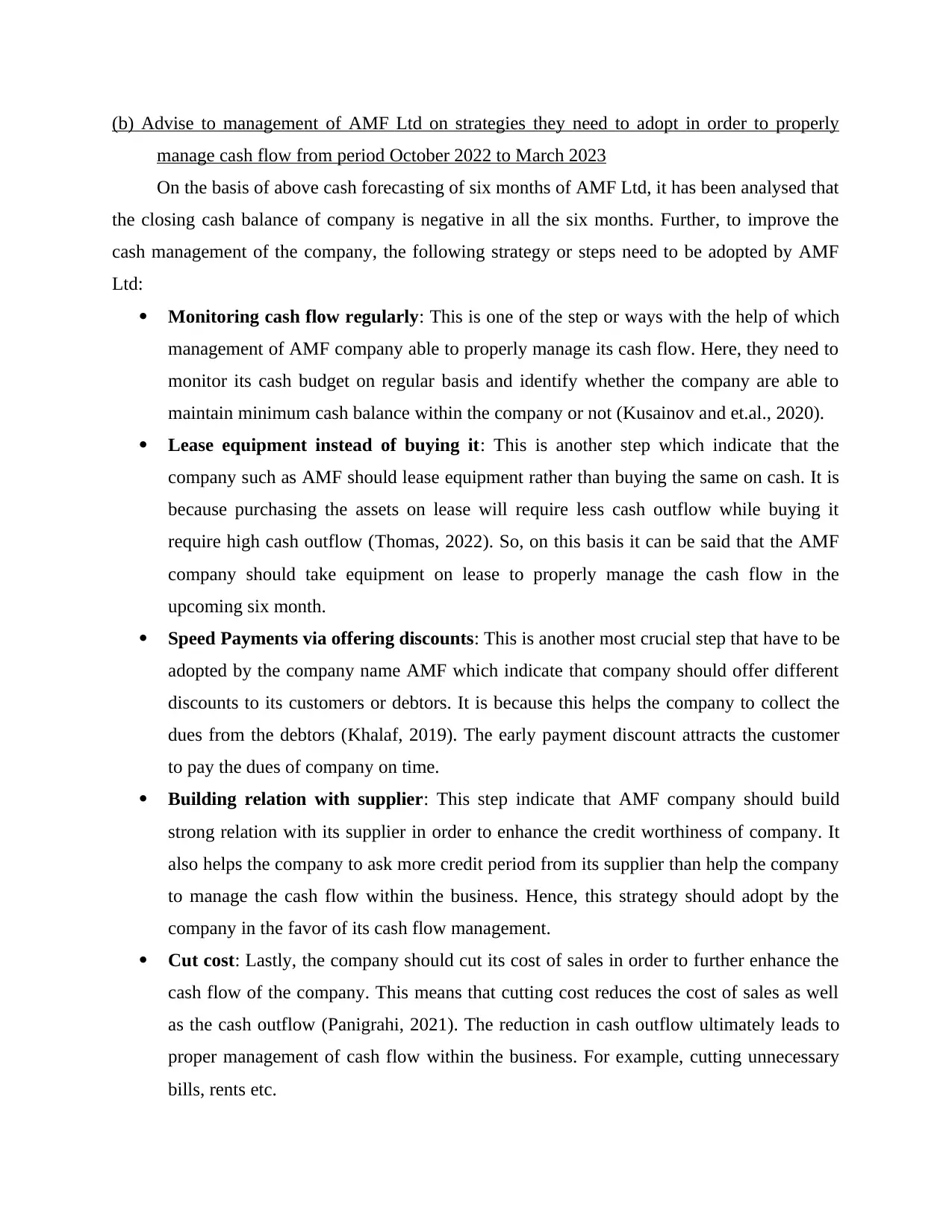
(b) Advise to management of AMF Ltd on strategies they need to adopt in order to properly
manage cash flow from period October 2022 to March 2023
On the basis of above cash forecasting of six months of AMF Ltd, it has been analysed that
the closing cash balance of company is negative in all the six months. Further, to improve the
cash management of the company, the following strategy or steps need to be adopted by AMF
Ltd:
Monitoring cash flow regularly: This is one of the step or ways with the help of which
management of AMF company able to properly manage its cash flow. Here, they need to
monitor its cash budget on regular basis and identify whether the company are able to
maintain minimum cash balance within the company or not (Kusainov and et.al., 2020).
Lease equipment instead of buying it: This is another step which indicate that the
company such as AMF should lease equipment rather than buying the same on cash. It is
because purchasing the assets on lease will require less cash outflow while buying it
require high cash outflow (Thomas, 2022). So, on this basis it can be said that the AMF
company should take equipment on lease to properly manage the cash flow in the
upcoming six month.
Speed Payments via offering discounts: This is another most crucial step that have to be
adopted by the company name AMF which indicate that company should offer different
discounts to its customers or debtors. It is because this helps the company to collect the
dues from the debtors (Khalaf, 2019). The early payment discount attracts the customer
to pay the dues of company on time.
Building relation with supplier: This step indicate that AMF company should build
strong relation with its supplier in order to enhance the credit worthiness of company. It
also helps the company to ask more credit period from its supplier than help the company
to manage the cash flow within the business. Hence, this strategy should adopt by the
company in the favor of its cash flow management.
Cut cost: Lastly, the company should cut its cost of sales in order to further enhance the
cash flow of the company. This means that cutting cost reduces the cost of sales as well
as the cash outflow (Panigrahi, 2021). The reduction in cash outflow ultimately leads to
proper management of cash flow within the business. For example, cutting unnecessary
bills, rents etc.
manage cash flow from period October 2022 to March 2023
On the basis of above cash forecasting of six months of AMF Ltd, it has been analysed that
the closing cash balance of company is negative in all the six months. Further, to improve the
cash management of the company, the following strategy or steps need to be adopted by AMF
Ltd:
Monitoring cash flow regularly: This is one of the step or ways with the help of which
management of AMF company able to properly manage its cash flow. Here, they need to
monitor its cash budget on regular basis and identify whether the company are able to
maintain minimum cash balance within the company or not (Kusainov and et.al., 2020).
Lease equipment instead of buying it: This is another step which indicate that the
company such as AMF should lease equipment rather than buying the same on cash. It is
because purchasing the assets on lease will require less cash outflow while buying it
require high cash outflow (Thomas, 2022). So, on this basis it can be said that the AMF
company should take equipment on lease to properly manage the cash flow in the
upcoming six month.
Speed Payments via offering discounts: This is another most crucial step that have to be
adopted by the company name AMF which indicate that company should offer different
discounts to its customers or debtors. It is because this helps the company to collect the
dues from the debtors (Khalaf, 2019). The early payment discount attracts the customer
to pay the dues of company on time.
Building relation with supplier: This step indicate that AMF company should build
strong relation with its supplier in order to enhance the credit worthiness of company. It
also helps the company to ask more credit period from its supplier than help the company
to manage the cash flow within the business. Hence, this strategy should adopt by the
company in the favor of its cash flow management.
Cut cost: Lastly, the company should cut its cost of sales in order to further enhance the
cash flow of the company. This means that cutting cost reduces the cost of sales as well
as the cash outflow (Panigrahi, 2021). The reduction in cash outflow ultimately leads to
proper management of cash flow within the business. For example, cutting unnecessary
bills, rents etc.

⊘ This is a preview!⊘
Do you want full access?
Subscribe today to unlock all pages.

Trusted by 1+ million students worldwide
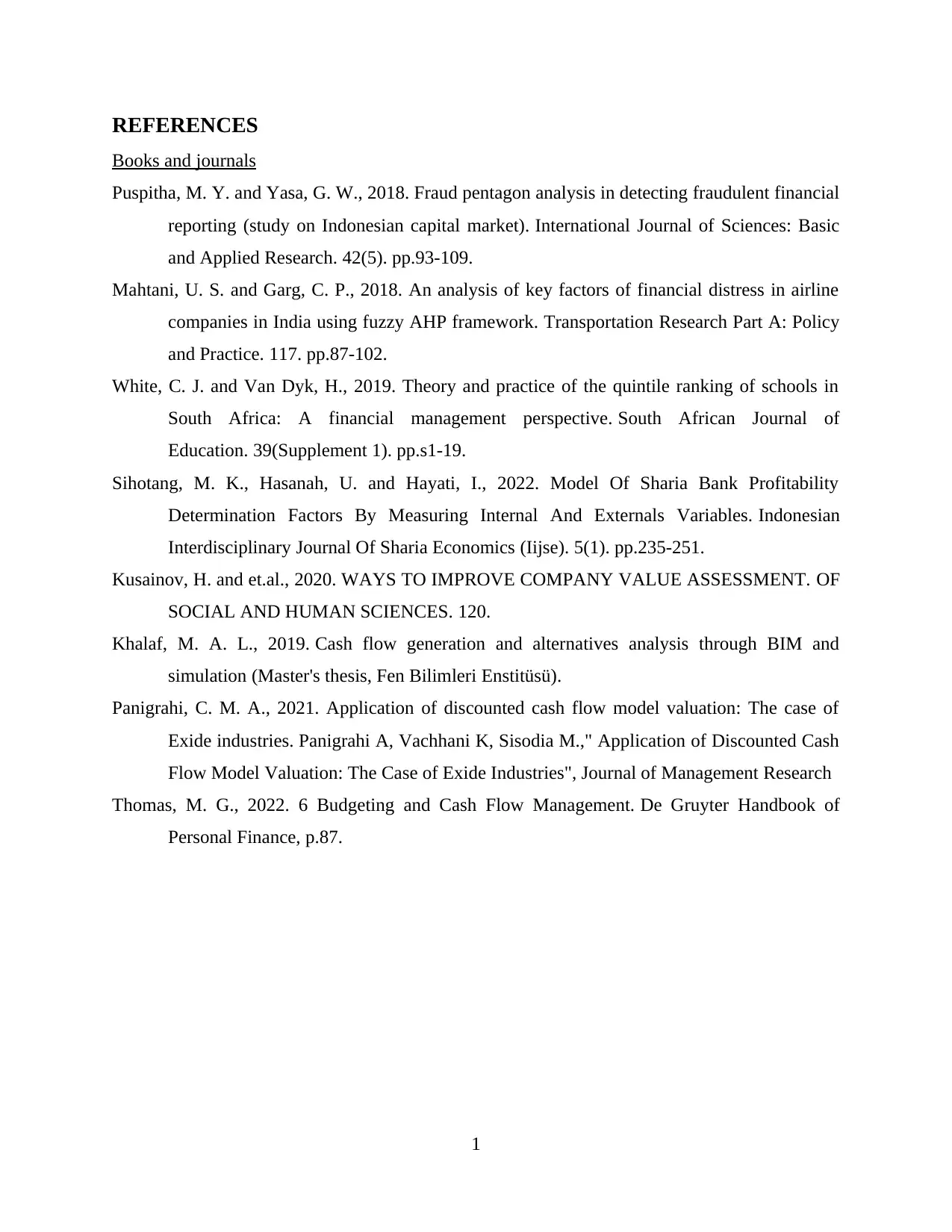
REFERENCES
Books and journals
Puspitha, M. Y. and Yasa, G. W., 2018. Fraud pentagon analysis in detecting fraudulent financial
reporting (study on Indonesian capital market). International Journal of Sciences: Basic
and Applied Research. 42(5). pp.93-109.
Mahtani, U. S. and Garg, C. P., 2018. An analysis of key factors of financial distress in airline
companies in India using fuzzy AHP framework. Transportation Research Part A: Policy
and Practice. 117. pp.87-102.
White, C. J. and Van Dyk, H., 2019. Theory and practice of the quintile ranking of schools in
South Africa: A financial management perspective. South African Journal of
Education. 39(Supplement 1). pp.s1-19.
Sihotang, M. K., Hasanah, U. and Hayati, I., 2022. Model Of Sharia Bank Profitability
Determination Factors By Measuring Internal And Externals Variables. Indonesian
Interdisciplinary Journal Of Sharia Economics (Iijse). 5(1). pp.235-251.
Kusainov, H. and et.al., 2020. WAYS TO IMPROVE COMPANY VALUE ASSESSMENT. OF
SOCIAL AND HUMAN SCIENCES. 120.
Khalaf, M. A. L., 2019. Cash flow generation and alternatives analysis through BIM and
simulation (Master's thesis, Fen Bilimleri Enstitüsü).
Panigrahi, C. M. A., 2021. Application of discounted cash flow model valuation: The case of
Exide industries. Panigrahi A, Vachhani K, Sisodia M.," Application of Discounted Cash
Flow Model Valuation: The Case of Exide Industries", Journal of Management Research
Thomas, M. G., 2022. 6 Budgeting and Cash Flow Management. De Gruyter Handbook of
Personal Finance, p.87.
1
Books and journals
Puspitha, M. Y. and Yasa, G. W., 2018. Fraud pentagon analysis in detecting fraudulent financial
reporting (study on Indonesian capital market). International Journal of Sciences: Basic
and Applied Research. 42(5). pp.93-109.
Mahtani, U. S. and Garg, C. P., 2018. An analysis of key factors of financial distress in airline
companies in India using fuzzy AHP framework. Transportation Research Part A: Policy
and Practice. 117. pp.87-102.
White, C. J. and Van Dyk, H., 2019. Theory and practice of the quintile ranking of schools in
South Africa: A financial management perspective. South African Journal of
Education. 39(Supplement 1). pp.s1-19.
Sihotang, M. K., Hasanah, U. and Hayati, I., 2022. Model Of Sharia Bank Profitability
Determination Factors By Measuring Internal And Externals Variables. Indonesian
Interdisciplinary Journal Of Sharia Economics (Iijse). 5(1). pp.235-251.
Kusainov, H. and et.al., 2020. WAYS TO IMPROVE COMPANY VALUE ASSESSMENT. OF
SOCIAL AND HUMAN SCIENCES. 120.
Khalaf, M. A. L., 2019. Cash flow generation and alternatives analysis through BIM and
simulation (Master's thesis, Fen Bilimleri Enstitüsü).
Panigrahi, C. M. A., 2021. Application of discounted cash flow model valuation: The case of
Exide industries. Panigrahi A, Vachhani K, Sisodia M.," Application of Discounted Cash
Flow Model Valuation: The Case of Exide Industries", Journal of Management Research
Thomas, M. G., 2022. 6 Budgeting and Cash Flow Management. De Gruyter Handbook of
Personal Finance, p.87.
1
Paraphrase This Document
Need a fresh take? Get an instant paraphrase of this document with our AI Paraphraser

2
1 out of 11
Related Documents
Your All-in-One AI-Powered Toolkit for Academic Success.
+13062052269
info@desklib.com
Available 24*7 on WhatsApp / Email
![[object Object]](/_next/static/media/star-bottom.7253800d.svg)
Unlock your academic potential
Copyright © 2020–2025 A2Z Services. All Rights Reserved. Developed and managed by ZUCOL.





